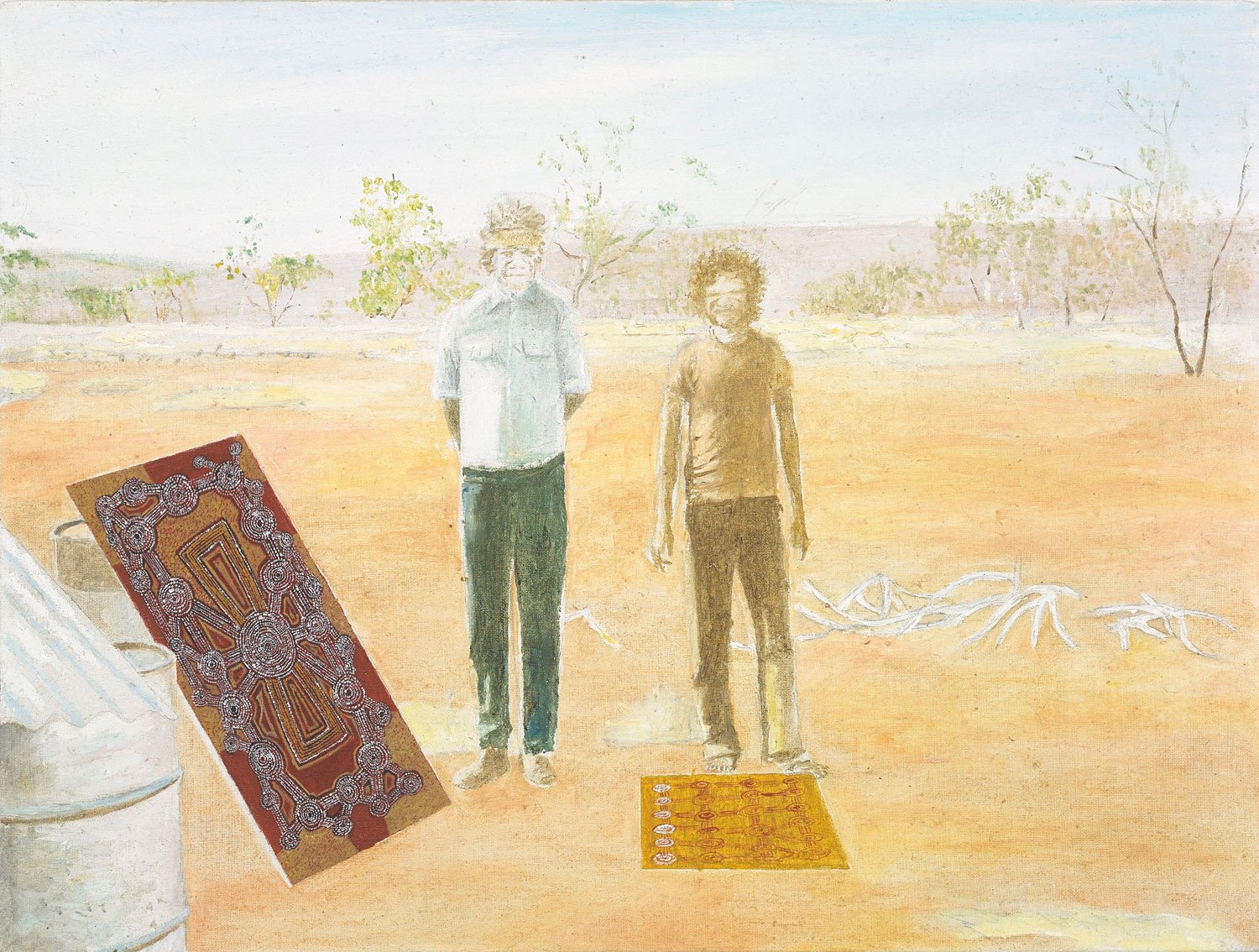Tim Johnson
Freddie West and George Yapa Yapa, 1982
acrylic on linen
45.5
x 61.0
cm
signed, dated and inscribed with title ‘Freddy West & George Yapa Yapa/Tim Johnson 1982’ and with Perspecta sticker (on the reverse)
Provenance
The artist
Peter Myers, Sydney
Private collection, Sydney
Exhibited
Australian Perspecta, Art Gallery of New South Wales, Sydney, 12 May – 26 June 1983
Literature
Australian Perspecta, exh. cat. Art Gallery of New South Wales, Sydney, 1983, p.52
"I first saw Papunya painting in about 1977, when I'd been painting again for about five years, but I made my first contact with Aboriginal artists in 1980. When I first went to Papunya, I took photographs of people with their paintings, and when I got home I started painting the photographs. I was absorbing new ideas about painting from the work I was seeing. ...So I was using painting to document, and putting the performance into the process of painting. I was interested in the way Papunya painting and most Aboriginal art used imagery in the same way we use language - to tell a story, taking an overview like a map" (Tim Johnson interviewed by Nicholas Zurbrugg in Wayne Tunnicliffe & Julie Ewington, Tim Johnson - Painting Ideas, QAG & AGNSW, 2009, exh. cat. p.44)

‘…one has to work in a symbolic space, perhaps like the Buddhist Pure Land, or the mandala itself, to create an illusory reality or a virtual reality in which the space that the artwork occupies is revealed to the audience that can read enough signs to unravel its meanings.’ (Tim Johnson, quoted in Wayne Tunnicliffe, ‘Pure Land Painting’ in Tim Johnson: Painting Ideas, Art Gallery of New South Wales, Sydney, p. 58.)
Tim Johnson’s paintings are fascinating cross-cultural documents that embody the inherent multiculturalism within contemporary society. Born and trained in Sydney, Johnson began as a conceptual and performance artist, establishing the Inhibodress art space in Sydney along with Mike Parr and Peter Kennedy. In 1975-76, Johnson travelled to North and South-East Asia, where Buddhist spirituality and culture left an indelible impression.
Johnson first travelled to Papunya, Northern Territory, in 1980, where he learned dot painting with Aboriginal artists including Clifford Possum Tjapaltjarri. After seeking permission to continue incorporating indigenous techniques within his paintings, Johnson developed a visual vocabulary that placed the vibrancy of the dot alongside symbols and icons of Asian religion and folklore. The resultant paintings are spiritual landscapes, testaments to Johnson’s connections to different aesthetic traditions around the world. He and his then-wife, the writer and sociologist Vivien Johnson, were instrumental in introducing these Central Australian artists to the art market and increasing the Australian public's awareness and appreciation of First Nations art and culture.
More recently, his contemplation of mythology has led Johnson to popular culture, with symbols from science fiction, video games and Japanese anime being incorporated alongside traditional images of the Buddha or the lotus flower. The common feature of these disparate influences is the sense that there is a shared consciousness of images and symbols from all cultures that makes sense to audiences from all backgrounds.
Tim Johnson has worked and exhibited for almost five decades, both alone and collaboratively with the likes of Karma Phuntsok, My Le Thi and Clifford Possum Tjapaltjarri. In 2009-10, a major solo exhibition, Tim Johnson: Painting Ideas toured the Gallery of Modern Art, Brisbane, the Art Gallery of New South Wales, Sydney, and the Ian Potter Museum of Art, Melbourne. He showed in 2012 at The Unseen, the Fourth Guangzhou Triennial, China, and has been included in three Biennales of Sydney.